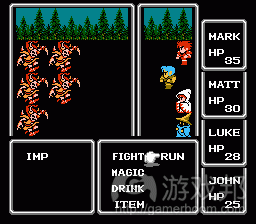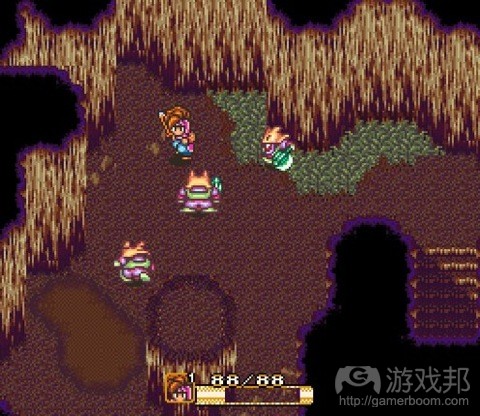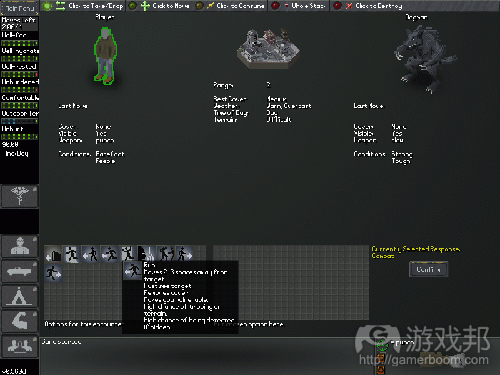举例探讨RPG游戏中的逃跑机制模式
作者:Lars Doucet
今天我想谈谈RPG中的跳跑机制。这些游戏通常更关注战斗机制,但却甚少涉及躲避及逃脱战斗的方法。这一点极为不同于我们现实世界中的常理,即斗不过总还躲得起。战斗会有受伤甚至是死亡的危险,而获胜通常也不会得到足以抵消战斗的现金和奖励。
因为电子游戏中的战斗风险更少,大家在游戏中就不需要像现实生活中那样逃命,有些游戏甚至根本就不允许玩家逃路。在此我将分析经典RPG过去几年的常用方法,并与各位分享一款开创了新局面的独立RPG所采用的新形式。
逃跑的理由
首先,逃跑总要有个理由。如果玩家一方在战斗之后能够恢复所有的命值和魔法值,并且游戏会自动保存每一步,那么在战斗之后,除了流失的时间,你几乎不会有其他损失。这就是《Defender’s Quest》的运行原理,它不需要逃跑机制——玩家只需要选择退出或重新开始战斗。
多数RPG是依靠持久挑战机制,其前提是玩家一方能够在早期的游戏中打败5个恶魔,就在之后击败4条恶龙。但这里的问题就在于,你能否接二连三地打败敌人,在不会耗尽供给和体力的情况下,从无数战役中幸存下来,并通过地下城。
这就是逃跑机制发挥作用的地方。当然,也许你能够在短时间内拿下2个食人魔,但势必无法承受自己一方的持续耗损。但如果你无法逃脱呢?那么你就只能被迫在极为不利的情况下应战。这就是逃命的基本风险/奖励动态。
《最终幻想》:“逃跑”指令
让我们以原版《最终幻想》为例,该游戏就含有最简单的逃跑机制。
为了成功逃跑,玩家角色的运气取决于骰子点数(0……Level+15)。据某网站攻略所称,原来的NES版本有个奇怪的漏洞会让玩家逃跑,而不是核对(0……WTF+15),WTF是一个取决于角色在战斗所处位置的不同数值。
结果就是只有位于第1 & 2方位的角色有足够的逃跑机会。在这类情况下,WTF值就是位于第3和第4方位的角色状态字节,所以在上述情况中,假如John死了,那么Matt逃跑的机率就会下降,受伤或者中毒等等。玩家一方陷入的麻烦越多,这个漏洞就会令其逃跑越发困难,所以你在彻底沦陷之前就要想法脱身。
如果没有这些漏洞,玩家根本不可能在《最终幻想》中逃脱。如果你抛骰子,你的整个团队就会立即逃走,如果你不抛骰子,就会浪费角色的机会。玩家没有必要为逃跑而取得“进展”。因为逃跑是单个角色的行动,你可以只派一两个角色逃跑,留下其余角色继续作战。
之后中的《最终幻想》游戏极大改善了逃跑机制。在《最终幻想4》中,摁压L和R键可以让角色逃跑。据我所知,你得持续摁压一定的时间,直到所有角色都逃跑为止。但是,他们会抛弃下你之前打胜战所赢得的四分之一钱财。
《最终幻想4》使用了活跃时间战斗系统,而不是严格的回合制系统,你可以独立选择战斗行动,逃跑或者不逃跑。逃跑会让你损失钱财,并撤出战场而不是完全暴露在敌人面前。角色还拥有减少逃跑时间的能力,以及使用道具和咒语在无任何财物惩罚的情况下迅速逃跑。
你在《最终幻想》游戏中几乎没有无法逃脱boss敌人的情况。
总而言之,《最终幻想》中的逃跑机制是一种简单的开启/关闭模式,这里不存在撤退概念,即退而未逃的情况。
《辐射》:撤退
在初版的2款《辐射》游戏中,玩家逃离战斗相对更直接一点——只要将你所有的角色拉到地图边缘即可。
与《最终幻想》一样,《辐射》是回合制战斗,但如果逃跑却会让玩家更接近游戏目标,无论他们是否在该回合中获胜。此外,只要你没被杀或阻碍,持续撤退就可以脱险。
这里的风险/奖励机制更有策略性——只要你开始逃跑,你就会向敌人出让最佳的战斗位置。此外,你的角色可能处于截然不同的位置,有些人可能陷入困境,所以你们能否全部脱险与你所处的战斗情形有很大关系。
《Secret of Mana》:有组织地逃亡
SNES经典游戏《Secret of Mana》是一款不含单独“战斗模式”的动作RPG,怪物会凭空出现,你要与它们即时战斗。要逃跑就很简单了——如果你想从战斗中撤退,只要一直奔跑就行。在CRPG领域,《Baldur’s Gate》也采用了类似的方法。
这更接近于现实世界中的逃跑,没有通常游戏中的形式感。其中的逃跑更有深度更为微妙,你可以在任何时间参与战斗或逃跑,但这类游戏中的逃跑就是指往某方向一直逃命,直到看不到敌人追上来为止。只要你还有个可行的出路,你就可以跑得比敌人还快,逃跑是一项微不足道的琐事,而不可避免的战斗通常会把所有的出路都堵上。
增加逃跑的深度
在现实生活中,逃跑通常不仅仅是一跑了之,其形式还包括:
1.逃离
2.增加距离/撤退
3.拒绝追赶
4.逃亡
5.悄悄开溜
《最终幻想》只运用到了第1种,《Baldur’s Gate》以及《Secret of Mana》则涉及到了第2和第3,但除了“闹事”却并没有真正触及第4和第5点。《辐射》的潜行/侦察系统最接近于使用了以上所有方法,但它还有进一步提升的空间。
上述所有游戏都有相当简单的逃跑系统,因为玩家逃跑比战斗更省时间。假如玩家只是偶尔才需要逃跑,那么还有什么必要为逃跑机制增加更多深度呢?
这里我们以独立CRPG游戏《Neo Scavenger》为例。至少以我的眼光来看,其游戏机制更像是“逃跑系统”而非“战斗系统”,这一点真的很棒。
《Neo Scavenger》
这款游戏中的战斗机制严格模仿现实生活的情形,也就是参与战斗很可能让你丧命或重伤,即使赢了也不例外。玩家要做的不是管理简单的攻打点数,而是关注血量流失、疲劳、饥饿、寒冷以及腹泻、体温过底和颅脑损伤等疾病和受伤问题。
我想起了《搏击俱乐部》中的场景,俱乐部中的成员得到的一项“家庭作业”就是去打架,但大家都没有完成。Edward Norton在旁白中表示,“这并没有那么简单。多数普通人,都会尽一切可能避免与人打架。”
当然,《Neo Scavenger》中有许多东西一开始就会试图干掉你,但只要谁占上风的形势明朗了,处于下风者就会开溜,而不是拼死相斗。通常情况下,处于弱势的就是玩家一方。
虽然这是基于回合制的战斗,却包含了逃跑的诸多细节。此外,逃跑还是一个你必须掌握的过程。首先,你需要保证自己和敌人之间有足够的距离——“射程”是核心的战斗变量之一,除非你和敌人之间隔着一定的距离,否则就无法摆脱战斗模式。你可以用不同的速度离开,奔跑和疾跑这类更快速的动作会增加你跌倒之类的风险。所以你与敌人之间有一定距离之后,就可以开始逃跑。
通常情况下,如果你很不幸地跌倒或者知人比你更快时,他们会追赶上你。如果你处于易受攻击的位置时,就可以采用新方法——你想站起来继续奔跑吗?如果他们在你试图爬起来时发动攻击,你就会再次跌倒。但你可以继续躺着将他们踢倒,迫使敌人失势,这样你就有时间爬起来重新逃跑。
如果敌人看不到你了,并且你有隐身术,你就可以找个掩体并在隐身状态下慢慢撤退。但不利的是,如果敌人在晚上袭击你,就可能就无法侦察到敌人,只能选择一个随机的方向盲目地逃跑。
当你逃出战斗模式后,这场战斗就结束了。敌人还会在地图上跟踪你,你可以选择继续逃亡与之拉开距离,掩盖你的行踪,找到藏身之处。你可以选择“隐身”和“跟踪”等技术来实现目的。
《Neo Scavenger》是我遇到的首款如此深入探索逃跑机制的游戏。我之前从未体验过如此有趣的逃跑方式。(本文为游戏邦/gamerboom.com编译,拒绝任何不保留版权的转载,如需转载请联系:游戏邦)
Run Away! Escape Mechanics in RPG’s.
by Lars Doucet
The following blog post, unless otherwise noted, was written by a member of Gamasutra’s community.
The thoughts and opinions expressed are those of the writer and not Gamasutra or its parent company.
(Originally posted on Rampant Games, re-posted to celebrate NEO Scavenger’s launch on Steam!)
Today, I’d like to talk about running away in RPG’s. These games give lots of attention to battles, but usually downplay the means of avoiding or escaping them. This is quite different from our everyday lives as well as the natural world, where flight is usually preferable to fight. Combat risks injury and often death, and the defeated generally don’t explode with cash and prizes sufficient to justify the conflict in the first place.
Since video game conflicts carry less risk, there’s less need for an escape mechanic than in the real world, and some don’t allow escape at all. Today I’ll be analyzing the approach classic RPG’s have taken over the years*, ending with a fascinating new approach in an Indie RPG that breaks a lot of new ground.
*I’m not nearly as well versed in CRPG lore as Jay, so I’m sure I’m going to leave out a lot of your favorites. Also, I’m pretty sure that most of my examples didn’t originate the concepts I’ll be exemplifying below.
A Reason to Run
First of all, there has to be a reason to escape. If your party regains all their health and mana after a battle, and the game autosaves every step of the way, you’ve got nothing to lose from defeat other than your time. This is how Defender’s Quest works, and thus it doesn’t need an escape mechanic – just an option to quit or restart the battle.
Most RPG’s are different, since they rely on endurance challenges. It’s pretty much a given that your party can defeat 5 imps in the early game or even 4 red dragons in the late game. The real question is whether you can get from one save point to the next, surviving dozens of battles and crawling through dungeons without running out of supplies and getting wiped out.
This is where escape comes in. Sure, you can probably take on 2 ogres in the short term, but you can’t afford the gradual wear and tear on your party. But what if you can’t pull off the escape?
Then you’ll be forced to fight anyway, and at a disadvantage. This is the fundamental risk/reward dynamic of running away.
Final Fantasy : the “RUN” command
Let’s start with the original Final Fantasy, which has one of the simplest escape mechanics.
To successfully escape, a character’s luck stat must be higher than a die roll of (0 … Level+15). At least, that’s what’s supposed to happen. According to this GameFAQs guide, a weird bug in the original NES version makes running away instead check against (0…WTF+15), where WTF is a different value depending on the character’s position in battle.
The upshot is that only characters in slots 1 & 2 have a reasonable chance of running away. In those cases, the WTF value is the status byte for characters in slots 3 and 4 respectively, so in the above picture, Matt’s chances of running away decrease if John dies, gets injured, is poisoned, etc. Perversely, this bug makes running away harder the more your party gets into trouble, so you have to commit to escaping before you get overwhelmed.
With our without bugs, running away in Final Fantasy is an all-or-nothing thing. If you make the die roll, your entire party escapes at once, and if you don’t, the character’s turn is wasted. There is no sense of making “progress” towards escaping. Since running is an individual character’s action, you can hedge your bets, sacrificing only one or two character actions on running while the rest try to beat back the enemy.
Running away improved substantially in future Final Fantasy games. In Final Fantasy IV, holding down the L & R keys makes the characters all attempt to run away. From what I can gather, you must hold down the keys for a certain amount of time, at which point all the characters will escape. However, they will drop an amount of money equal to 1/4 of what you would have gained from winning the battle.
Final Fantasy IV uses an active-time battle system rather than a strictly turn-based one, and you can start and stop running away independently of choosing battle actions. Thus, running away risks losing money and being distracted from fighting rather than leaving yourself completely exposed. Characters also had the ability to decrease the time taken to run (Porom’s “cry” ability), as well as use items and spells to escape immediately with no financial penalty.
Almost without exception, you cannot run from boss enemies in any Final Fantasy game.
To sum up, in Final Fantasy escape is a simple on/off affair, and there is no concept of retreat, ie, moving towards escape but having not yet achieved it.
Fallout : Retreat
In the original 2 Fallout games, escaping from combat was a bit more straightforward – just get all your characters to the edge of the map. This adds board position and retreat to the mix.
Like Final Fantasy, Fallout’s battles are turn based, but making an effort to escape gets you closer to the goal whether it succeeds on that turn or not. Furthermore, as long as you’re not killed or blocked, if you keep retreating you will eventually get away.
The risk/reward dynamic here is much more tactical – as soon as you start running away, you’re ceding the best position on the battlefield to the enemy. Furthermore, your characters might be in different places and some of them might be trapped, so whether you can even escape at all has a lot to do with the specifics of the fight you are in.
Secret of Mana : Organic Escape
SNES classic Secret of Mana was an action RPG where there was no separate “battle mode”, monsters just appeared on the overworld and you fought them in real time. This made escape rather simple – if you wanted to get away from a fight, you just kept running. In the CRPG world, Baldur’s Gate took a similar approach.
This is much closer to escape in the real world, and it’s lack of formalism adds both subtlety and sloppiness. There’s a lot of depth and nuance to running away when you can engage and disengage at any time, but in these games it essentially boils down to just running in one direction for a while until you can’t see the bad guys any more. As long as you have a viable exit and you can run faster than them, escape is trivial, and inescapable battles are usually ones where the exits are all locked.
Adding depth to escape
In real life, escape involves more than just running away, a full list could look like this:
Flee
Gain distance / retreat
Deny pursuit
Escape
Avoid detection after escape
Final Fantasy doesn’t go far beyond point 1, Baldur’s Gate and Secret of Mana get into 2 and 3, but other than “aggro” don’t really develop points 4 and 5. Fallout comes the closest to using the whole spectrum with its stealth/detection system, but it could go further.
All of the above games have fairly simple escape systems because the player always spend more time fighting than running away. What’s the point of adding lots of depth to escape if it’s something the player only needs to do occasionally?
That’s where Indie CRPG gem Neo Scavenger comes in. At least in my play-throughs, the combat engine is more of a “running away system” than a “battle system.” And it’s awesome.
Neo Scavenger
This game is basically about being a homeless person in a dystopian future filled with ferocious dog-men, looters, and disease. Early on, the simple discovery of a pair of pants and something larger than a plastic grocery bag to hold your things in feels like true riches indeed.
Combat in this game is closely modeled on real life, which is to say that fighting to the death will usually get you killed or horribly injured, even if you win. Instead of managing simple hit points, you have to deal with blood loss, fatigue, hunger, cold, as well as specific diseases and injuries like diarrhea, hypothermia, and head trauma.
I’m reminded of that scene from Fight Club, where the members are given a “homework assignment,” to get in a fight and lose. Edward Norton narrates, “This is not as easy as it sounds. Most people, normal people, will do just about anything to avoid a fight.”
Of course, tons of thing in Neo Scavenger will try to kill you at first sight, but as soon as it’s clear who has the upper hand, the loser will try to flee rather than fight to the death. Usually the loser is you.
Although battle is turn-based, it embodies escape in high detail. Furthermore, running away is a process you have to master. First, you need to put sufficient distance between yourself and the enemy – this value, “range” is one of the central battle variables. You can’t even attempt to escape battle mode unless you are a minimum distance from the enemy. You can move away at various speeds, and faster actions like running and sprinting carry higher risks of making you trip and fall. Once you’ve gotten far enough away, you can try to make your escape.
Usually the enemy will catch up to you once or twice when you have an unlucky fall or they have a lucky sprint. When you’re in a vulnerable position like this new options become available – do you want to try to get up so you can run on your next turn? If they land a hit while you’re getting up, you’ll fall back down. On the other hand, you could stay down and try to kick them in the leg, which will knock them down, forcing them to lose a turn, giving you time to get up and try running again.
If the enemy loses sight of you and you have the hiding skill, you can take cover and then slowly retreat while remaining hidden. On the flip side, if an enemy attacks you at night you might not be able to detect them and have no choice but to flee blindly in a random direction.
Once you’ve escaped battle mode, the fight isn’t over. The enemy will still pursue you on the overworld map, and now it’s up to you to keep gaining distance, covering your tracks, and finding a place to hide and lose them for good. This is easier if you choose skills like “hiding” and “tracking” like I usually do.
Neo Scavenger is the first game I’ve seen put this much thought and depth into escape mechanics. I’ve never had this much fun running for my life.(source:gamasutra)












































 闽公网安备35020302001549号
闽公网安备35020302001549号